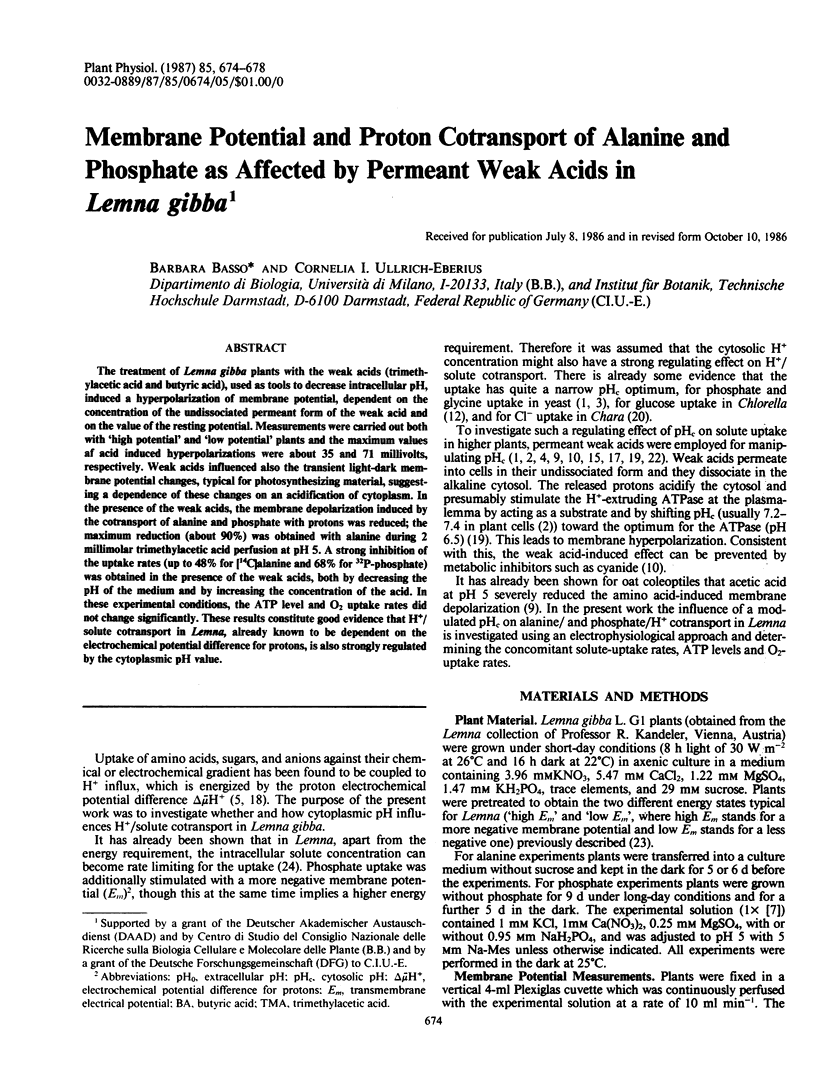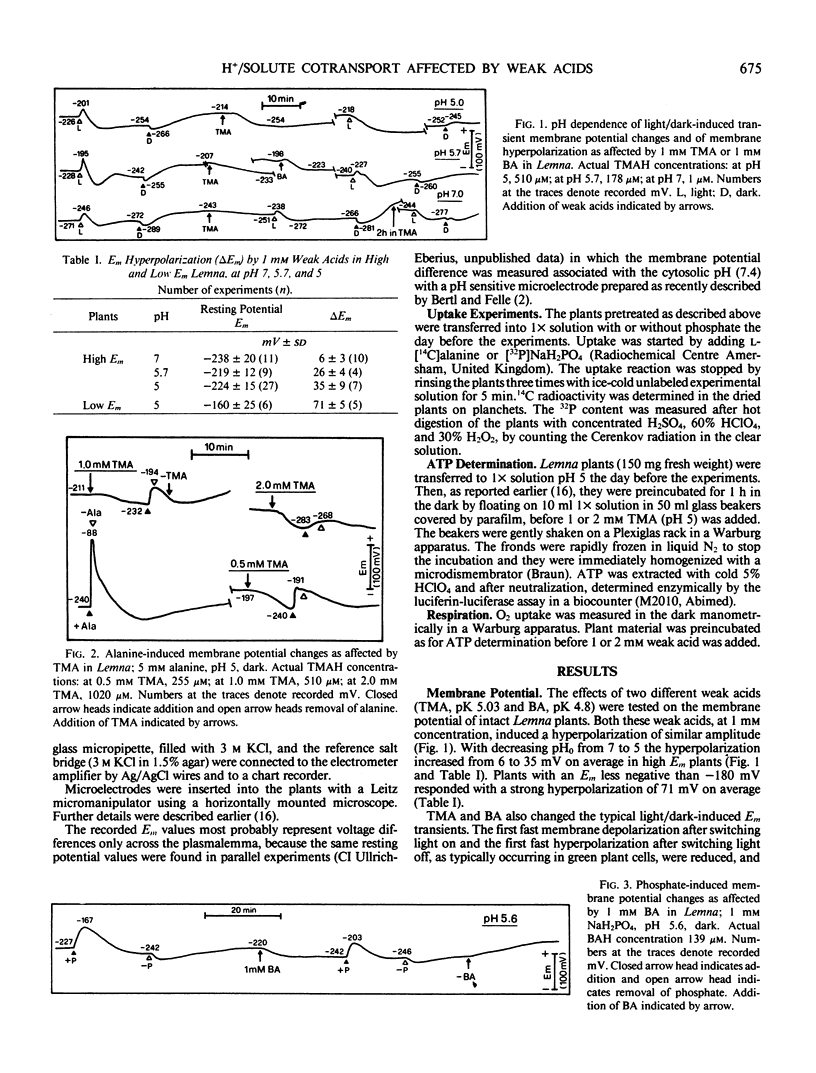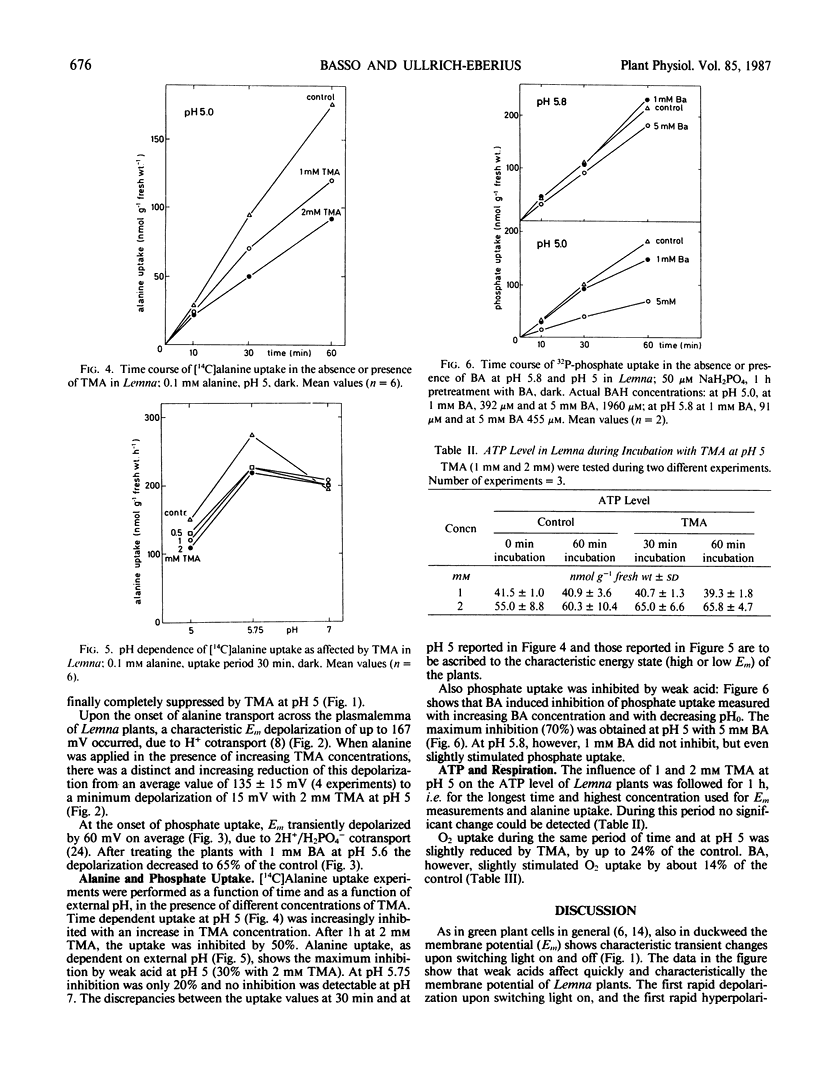Abstract
The treatment of Lemna gibba plants with the weak acids (trimethylacetic acid and butyric acid), used as tools to decrease intracellular pH, induced a hyperpolarization of membrane potential, dependent on the concentration of the undissociated permeant form of the weak acid and on the value of the resting potential. Measurements were carried out both with `high potential' and `low potential' plants and the maximum values af acid induced hyperpolarizations were about 35 and 71 millivolts, respectively. Weak acids influenced also the transient light-dark membrane potential changes, typical for photosynthesizing material, suggesting a dependence of these changes on an acidification of cytoplasm. In the presence of the weak acids, the membrane depolarization induced by the cotransport of alanine and phosphate with protons was reduced; the maximum reduction (about 90%) was obtained with alanine during 2 millimolar trimethylacetic acid perfusion at pH 5. A strong inhibition of the uptake rates (up to 48% for [14C]alanine and 68% for 32P-phosphate) was obtained in the presence of the weak acids, both by decreasing the pH of the medium and by increasing the concentration of the acid. In these experimental conditions, the ATP level and O2 uptake rates did not change significantly. These results constitute good evidence that H+/solute cotransport in Lemna, already known to be dependent on the electrochemical potential difference for protons, is also strongly regulated by the cytoplasmic pH value.
Full text
PDF




Selected References
These references are in PubMed. This may not be the complete list of references from this article.
- Ballarin-Denti A., Den Hollander J. A., Sanders D., Slayman C. W., Slayman C. L. Kinetics and pH-dependence of glycine-proton symport in Saccharomyces cerevisiae. Biochim Biophys Acta. 1984 Nov 21;778(1):1–16. doi: 10.1016/0005-2736(84)90442-5. [DOI] [PubMed] [Google Scholar]
- Borst-Pauwels G. W., Peters P. H. Effect of the medium pH and the cell pH upon the kinetical parameters of phosphate uptake by yeast. Biochim Biophys Acta. 1977 May 2;466(3):488–495. doi: 10.1016/0005-2736(77)90341-8. [DOI] [PubMed] [Google Scholar]
- Higinbotham N., Etherton B., Foster R. J. Effect of External K, NH(4), Na, Ca, Mg, and H Ions on the Cell Transmembrane Electropotential of Avena Coleoptile. Plant Physiol. 1964 Mar;39(2):196–203. doi: 10.1104/pp.39.2.196. [DOI] [PMC free article] [PubMed] [Google Scholar]
- Kinraide T. B., Etherton B. Electrical evidence for different mechanisms of uptake for basic, neutral, and acidic amino acids in oat coleoptiles. Plant Physiol. 1980 Jun;65(6):1085–1089. doi: 10.1104/pp.65.6.1085. [DOI] [PMC free article] [PubMed] [Google Scholar]
- Kinraide T. B., Etherton B. Energy Coupling in H-Amino Acid Cotransport : ATP DEPENDENCE OF THE SPONTANEOUS ELECTRICAL REPOLARIZATION OF THE CELL MEMBRANES IN OAT COLEOPTILES. Plant Physiol. 1982 Mar;69(3):648–652. doi: 10.1104/pp.69.3.648. [DOI] [PMC free article] [PubMed] [Google Scholar]
- Komor E., Schwab W. G., Tanner W. The effect of intracellular pH on the rate of hexose uptake in Chlorella. Biochim Biophys Acta. 1979 Aug 23;555(3):524–530. doi: 10.1016/0005-2736(79)90406-1. [DOI] [PubMed] [Google Scholar]
- Romani G., Marrè M. T., Bellando M., Alloatti G., Marrè E. H extrusion and potassium uptake associated with potential hyperpolarization in maize and wheat root segments treated with permeant weak acids. Plant Physiol. 1985 Nov;79(3):734–739. doi: 10.1104/pp.79.3.734. [DOI] [PMC free article] [PubMed] [Google Scholar]
- Ullrich-Eberius C. I., Novacky A., Ball E. Effect of cyanide in dark and light on the membrane potential and the ATP level of young and mature green tissues of higher plants. Plant Physiol. 1983 May;72(1):7–15. doi: 10.1104/pp.72.1.7. [DOI] [PMC free article] [PubMed] [Google Scholar]


